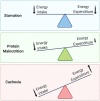Diverging metabolic programmes and behaviours during states of starvation, protein malnutrition, and cachexia
- PMID: 32985801
- PMCID: PMC7749623
- DOI: 10.1002/jcsm.12630
Diverging metabolic programmes and behaviours during states of starvation, protein malnutrition, and cachexia
Abstract
Background: Our evolutionary history is defined, in part, by our ability to survive times of nutrient scarcity. The outcomes of the metabolic and behavioural adaptations during starvation are highly efficient macronutrient allocation, minimization of energy expenditure, and maximized odds of finding food. However, in different contexts, caloric deprivation is met with vastly different physiologic and behavioural responses, which challenge the primacy of energy homeostasis.
Methods: We conducted a literature review of scientific studies in humans, laboratory animals, and non-laboratory animals that evaluated the physiologic, metabolic, and behavioural responses to fasting, starvation, protein-deficient or essential amino acid-deficient diets, and cachexia. Studies that investigated the changes in ingestive behaviour, locomotor activity, resting metabolic rate, and tissue catabolism were selected as the focus of discussion.
Results: Whereas starvation responses prioritize energy balance, both protein malnutrition and cachexia present existential threats that induce unique adaptive programmes, which can exacerbate the caloric insufficiency of undernutrition. We compare and contrast the behavioural and metabolic responses and elucidate the mechanistic pathways that drive state-dependent alterations in energy seeking and partitioning.
Conclusions: The evolution of energetically inefficient metabolic and behavioural responses to protein malnutrition and cachexia reveal a hierarchy of metabolic priorities governed by discrete regulatory networks.
Keywords: Cachexia; Evolution; Metabolism; Protein malnutrition; Starvation.
© 2020 The Authors. Journal of Cachexia, Sarcopenia and Muscle published by John Wiley & Sons Ltd on behalf of Society on Sarcopenia, Cachexia and Wasting Disorders.
Figures



References
-
- Cahill GF Jr. Starvation in man. N Engl J Med 1970;282:668–675. - PubMed
-
- Cahill GF Jr. Fuel metabolism in starvation. Annu Rev Nutr 2006;26:1–22. - PubMed
-
- Heilbronn LK, Ravussin E. Calorie restriction and aging: review of the literature and implications for studies in humans. Am J Clin Nutr 2003;78:361–369. - PubMed
-
- Lowell BB. New neuroscience of homeostasis and drives for food, water, and salt. N Engl J Med 2019;380:459–471. - PubMed
-
- Edholm OG. Energy balance in man studies carried out by the Division of Human Physiology, National Institute for Medical Research. J Hum Nutr 1977;31:413–431. - PubMed
Publication types
MeSH terms
Grants and funding
LinkOut - more resources
Full Text Sources
Medical
Miscellaneous

